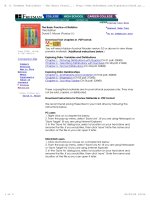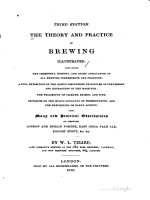Washington manual of nephrology 3rd ed subspeciality consult
Bạn đang xem bản rút gọn của tài liệu. Xem và tải ngay bản đầy đủ của tài liệu tại đây (8.16 MB, 723 trang )
THE WASHINGTON MANUAL™
Nephrology
Subspecialty Consult
Third Edition
Editors
Steven Cheng, MD
Assistant Professor of Medicine
Department of Internal Medicine
Renal Division
Washington University School of Medicine
St. Louis, Missouri
Anitha Vijayan, MD
Associate Professor of Medicine
Department of Internal Medicine
Renal Division
Washington University School of Medicine
St. Louis, Missouri
Series Editors
Katherine E. Henderson, MD
Assistant Professor of Clinical Medicine
Department of Medicine
Division of Medical Education
Washington University School of Medicine
Barnes-Jewish Hospital
St. Louis, Missouri
Thomas M. De Fer, MD
Associate Professor of Internal Medicine
Washington University School of Medicine
St. Louis, Missouri
2
3
Acquisitions Editor: Sonya Seigafuse
Product Manager: Kerry Barrett
Vendor Manager: Bridgett Dougherty
Marketing Manager: Kimberly Schonberger
Manufacturing Manager: Ben Rivera
Design Coordinator: Stephen Druding
Editorial Coordinator: Katie Sharp
Production Service: Aptara, Inc.
© 2012 by Department of Medicine, Washington University School
of Medicine
Printed in China
All rights reserved. This book is protected by copyright. No part of this
book may be reproduced in any form by any means, including
photocopying, or utilized by any information storage and retrieval
system without written permission from the copyright owner, except for
brief quotations embodied in critical articles and reviews. Materials
appearing in this book prepared by individuals as part of their o cial
duties as U.S. government employees are not covered by the abovementioned copyright.
Library of Congress Cataloging-in-Publication Data
The Washington manual nephrology subspecialty consult. — 3rd ed. /
editors, Steven Cheng, Anitha Vijayan.
p. ; cm. — (Washington manual subspecialty consult series)
Nephrology subspecialty consult
Includes bibliographical references and index.
ISBN 978-1-4511-1425-6 (alk. paper) — ISBN 1-4511-1425-7 (alk.
paper)
I. Cheng, Steven. II. Vijayan, Anitha. III. Title: Nephrology subspecialty
consult. IV. Series: Washington manual subspecialty consult series.
4
[DNLM: 1. Kidney Diseases—diagnosis—Handbooks. 2. Kidney Diseases
—therapy—Handbooks.
3. Nephrology—methods—Handbooks. WJ 39]
616.691—dc23
2011050022
The Washington Manual™ is an intent-to-use mark belonging to
Washington University in St. Louis to which international legal
protection applies. The mark is used in this publication by LWW under
license from Washington University.
Care has been taken to con rm the accuracy of the information
presented and to describe generally accepted practices. However, the
authors, editors, and publisher are not responsible for errors or omissions
or for any consequences from application of the information in this book
and make no warranty, expressed or implied, with respect to the
currency, completeness, or accuracy of the contents of the publication.
Application of the information in a particular situation remains the
professional responsibility of the practitioner.
The authors, editors, and publisher have exerted every e ort to ensure
that drug selection and dosage set forth in this text are in accordance
with current recommendations and practice at the time of publication.
However, in view of ongoing research, changes in government
regulations, and the constant ow of information relating to drug
therapy and drug reactions, the reader is urged to check the package
insert for each drug for any change in indications and dosage and for
added warnings and precautions. This is particularly important when the
recommended agent is a new or infrequently employed drug.
Some drugs and medical devices presented in the publication have Food
and Drug Administration (FDA) clearance for limited use in restricted
research settings. It is the responsibility of the health care provider to
ascertain the FDA status of each drug or device planned for use in their
clinical practice.
5
To purchase additional copies of this book, call our customer service
department at (800) 638-3030 or fax orders to (301) 223-2320.
International customers should call (301) 223-2300.
Visit Lippincott Williams & Wilkins on the Internet: at LWW.com.
Lippincott Williams & Wilkins customer service representatives are
available from 8:30 am to 6 pm, EST.
10 9 8 7 6 5 4 3 2 1
6
Contributing Authors
Raghavender Boothpur, MD
Clinical Fellow
Department of Internal Medicine
Renal Division
Washington University School of Medicine
St. Louis, Missouri
Lyndsey Bowman, PharmD
Clinical Pharmacist
Abdominal Organ Transplant
Barnes-Jewish Hospital
St. Louis, Missouri
Ying Chen, MD
Instructor
Department of Internal Medicine
Renal Division
Washington University School of Medicine
St. Louis, Missouri
Steven Cheng, MD
Assistant Professor of Medicine
Department of Internal Medicine
Renal Division
Washington University School of Medicine
St. Louis, Missouri
Sindhu Garg, MD
Clinical Fellow
Department of Internal Medicine
Renal Division
7
Washington University School of Medicine
St. Louis, Missouri
Yekaterina Gincherman, MD
Clinical Fellow
Department of Internal Medicine
Renal Division
Washington University School of Medicine
St. Louis, Missouri
Seth Goldberg, MD
Assistant Professor of Medicine
Department of Internal Medicine
Renal Division
Washington University School of Medicine
St. Louis, Missouri
Ethan Hoerschgen, MD
Clinical Fellow
Department of Internal Medicine
Renal Division
Washington University School of Medicine
St. Louis, Missouri
Jennifer Iuppa, PharmD
Clinical Pharmacist
Lung Transplant
Barnes-Jewish Hospital
St. Louis, Missouri
Judy L. Jang, MD
Clinical Fellow
Department of Internal Medicine
Renal Division
8
Washington University School of Medicine
St. Louis, Missouri
Peter J. Juran, MD
Clinical Fellow
Department of Internal Medicine
Renal Division
Washington University School of Medicine
St. Louis, Missouri
Syed A. Khalid, MD
Clinical Fellow
Department of Internal Medicine
Renal Division
Washington University School of Medicine
St. Louis, Missouri
Christina L. Klein, MD
Assistant Professor of Medicine
Department of Internal Medicine
Renal Division
Washington University School of Medicine
St. Louis, Missouri
Tingting Li, MD
Assistant Professor of Medicine
Department of Internal Medicine
Renal Division
Washington University School of Medicine
St. Louis, Missouri
Biju Marath, MD
Clinical Fellow
Department of Internal Medicine
9
Renal Division
Washington University School of Medicine
St. Louis, Missouri
Imran A. Memon, MD
Clinical Fellow
Department of Internal Medicine
Renal Division
Washington University School of Medicine
St. Louis, Missouri
Georges Saab, MD
Assistant Professor of Medicine
Department of Internal Medicine
Renal Division
Washington University School of Medicine
St. Louis, Missouri
Sadashiv Santosh, MD
Clinical Fellow
Department of Internal Medicine
Renal Division
Washington University School of Medicine
St. Louis, Missouri
Andrew Siedlecki, MD
Instructor
Department of Internal Medicine
Renal Division
Washington University School of Medicine
St. Louis, Missouri
Nicholas Taraska, MD
Clinical Fellow
10
Department of Internal Medicine
Renal Division
Washington University School of Medicine
St. Louis, Missouri
Ahsan Usman, MD
Clinical Fellow
Department of Internal Medicine
Renal Division
Washington University School of Medicine
St. Louis, Missouri
Anitha Vijayan, MD
Associate Professor of Medicine
Department of Internal Medicine
Renal Division
Washington University School of Medicine
St. Louis, Missouri
11
Chairman’s Note
I
t is a pleasure to present the new edition of The Washington Manual®
Subspecialty Consult Series: Nephrology Subspecialty Consult. This pocketsize book continues to be a primary reference for medical students,
interns, residents, and other practitioners who need ready access to
practical clinical information to diagnose and treat patients with a wide
variety of disorders. Medical knowledge continues to increase at an
astounding rate, which creates a challenge for physicians to keep up with
the biomedical discoveries, genetic and genomic information, and novel
therapeutics that can positively impact patient outcomes. The Washington
Manual Subspecialty Series addresses this challenge by concisely and
practically providing current scienti c information for clinicians to aid
them in the diagnosis, investigation, and treatment of common medical
conditions.
I want to personally thank the authors, which include house o cers,
fellows, and attendings at Washington University School of Medicine and
Barnes-Jewish Hospital. Their commitment to patient care and education
is unsurpassed, and their e orts and skill in compiling this manual are
evident in the quality of the nal product. In particular, I would like to
acknowledge our editors, Drs. Steven Cheng and Anitha Vijayan, and the
series editors, Drs. Katherine Henderson and Tom De Fer, who have
worked tirelessly to produce another outstanding edition of this manual. I
would also like to thank Dr. Melvin Blanchard, Chief of the Division of
Medical Education in the Department of Medicine at Washington
University School of Medicine, for his advice and guidance. I believe this
Subspecialty Manual will meet its desired goal of providing practical
knowledge that can be directly applied at the bedside and in outpatient
settings to improve patient care.
Victoria J. Fraser, MD
Dr. J. William Campbell Professor
Interim Chairman of Medicine
Co-Director of the Infectious Disease Division
12
Washington University School of Medicine
13
Preface
T
he rst and second editions of The Washington Manual Nephrology
Subspecialty Consult achieved the goal of the “subspecialty” series because
they were well written, well organized, and served as an e cient bedside
resource for residents and students. The hope of this and future editions is
to build on that success by updating content with new developments
while maintaining the original high standards.
The eld of nephrology is changing rapidly, as new advances change
the management of acute kidney injury (AKI), chronic kidney disease,
and renal transplantation. AKI continues to be a life-threatening problem
for the hospitalized patient, and new clinical trials have addressed the
role of intensive renal replacement therapy in AKI. Glomerulonephritides
generate signi cant challenges to the nephrologist as we strive to treat
the patient e ectively but at the same time try to minimize side e ects
from the treatment regimen. Newer agents have been added as induction
therapies to decrease rejection rates after renal transplantation. Early
initiation of hemodialysis has recently been proven to be not beneficial in
patients with chronic kidney disease.
The eld of nephrology remains a fascinating, challenging, and
exciting area of internal medicine. Electrolyte and acid–base problems
will always pose an interesting and thought-provoking dilemma to the
trainee and the attending alike. The thrill of working up a patient with
hyponatremia or narrowing down the di erential diagnoses to get to the
underlying etiology of hypokalemia never changes with time, and we
hope to transfer our passion of nephrology to medical students and
residents and inspire them to pursue a career in nephrology.
We would like to acknowledge and thank the authors for all the time
and e ort vested in this publication. We also would like to extend our
gratitude to Katherine Henderson, MD, who gave us invaluable guidance
and feedback. We hope the readers will nd this publication to be a
relevant, informative, and useful tool in their day-to-day clinical practice.
14
Last, but not least, we would like to thank our families—Vichu, Maya,
Dev, and our parents for their love and support.
—AV and SC
15
Contents
Contributing Authors
Chairman’s Note
Preface
PART I. GENERAL APPROACH TO KIDNEY DISEASE
1. Art and Science of Urinalysis
Biju Marath and Steven Cheng
2. Assessment of Kidney Function
Imran A. Memon
3. Renal Biopsy
Imran A. Memon
4. Approach to Proteinuria
Peter J. Juran
5. Approach to Hematuria
Peter J. Juran
PART II. ELECTROLYTES AND ACID–BASE DISORDERS
6. Disorders of Water Balance
Georges Saab
7. Disorders of Potassium Balance
Sadashiv Santosh
16
8. Disorders of Calcium Metabolism
Yekaterina Gincherman
9. Disorders of Phosphorus Metabolism
Yekaterina Gincherman
10. Acid–Base Disorders
Biju Marath and Steven Cheng
PART III. ACUTE KIDNEY INJURY AND CONTINUOUS RENAL
REPLACEMENT
11. Overview and Management of Acute Kidney Injury
Andrew Siedlecki and Anitha Vijayan
12. Prerenal and Postrenal Acute Kidney Injury
Judy L. Jang and Anitha Vijayan
13. Intrinsic Causes of Acute Kidney Injury
Judy L. Jang
14. Contrast Induced Nephropathy
Ethan Hoerschgen
15. Renal Replacement Therapy in Acute Kidney Injury
Anitha Vijayan
PART IV. CAUSES OF KIDNEY DISEASE
16. Overview and Approach to the Patient with Glomerular Disease
Syed A. Khalid
17. Primary Glomerulopathies
Ying Chen
17
18. Secondary Glomerular Diseases
Tingting Li
19. Diabetic Nephropathy
Steven Cheng
20. Renal Artery Stenosis and Renovascular Hypertension
Ahsan Usman
21. Cystic Diseases of the Kidney
Seth Goldberg
PART V. PREGNANCY AND NEPHROLITHIASIS
22. Renal Diseases in Pregnancy
Sindhu Garg and Tingting Li
23. Nephrolithiasis
Raghavender Boothpur
PART VI. CHRONIC KIDNEY DISEASE
24. Management of Chronic Kidney Disease
Nicholas Taraska and Anitha Vijayan
25. Hemodialysis
Steven Cheng
26. Peritoneal Dialysis
Seth Goldberg
27. Principles of Drug Dosing in Renal Impairment
Lyndsey Bowman and Jennifer Iuppa
28. Care of the Renal Transplant Patient
Christina L. Klein
18
Christina L. Klein
Appendixes
A. Red Flag Drugs That May Cause Renal Impairment
B. Mechanisms of Nephrotoxicity and Alternatives to Some Common Drugs
C. Common Medications with Active Metabolites
D. Dosing Adjustments for Antimicrobials
E. Dosing Adjustments for Antiretrovirals
Index
19
1
Art and Science of Urinalysis
Biju Marath and Steven Cheng
GENERAL PRINCIPLES
Urinalysis is the physical, chemical, and microscopic examination of
urine, and is a key aspect in the evaluation of renal and urinary tract
disease.
DIAGNOSIS
When used properly, the urinalysis can offer innumerable insights into a
broad variety of diagnoses. Proper examination of the urine consists
of two parts: (a) the urine dipstick test and (b) the sediment
evaluation by light microscopy. The presence or absence of features on
urinalysis can be useful in narrowing diagnostic possibilities.1–5
The urine dipstick test gives insight into the physical and chemical
parameters of the urine. These properties can be invaluable in the
assessment of infections, inflammation, glucose control, acid–base
balance, hematuria, proteinuria, and intravascular volume status, to
name but a few conditions.
Microscopic analysis allows for sediment evaluation. Since the
characteristics of urinary sediment vary depending on the site of injury,
this assessment is helpful in localizing the injury in renal parenchymal
disease.
Specimen Collection
Urine should ideally be examined immediately or no longer than 2
hours after collection.
20
Prolonged standing causes urine to become progressively more alkaline
(urea is broken down, generating ammonia). The higher pH dissolves
casts and promotes cell lysis.
If delay is inevitable, urine can be preserved for up to 6 hours if
refrigerated at +2 to +8°C. Refrigeration may result in precipitation of
phosphates or crystals.
Preservatives such as formaldehyde, glutaraldehyde, “cellFIX,” and tubes
containing lyophilized borate-formate sorbitol powder have been used to
maintain the formed elements of the urine samples.
The method for preparing a urine sample is given in Table 1-1.
Physical Properties
Visual inspection and notation of other general physical characteristics of
a urine sample can yield important diagnostic information. The main
physical properties to be determined include color, clarity, odor, and
specific gravity.
Color
Normal urine is pale to yellow in color. Dilute urine appears lighter
and concentrated urine attains a darker yellow to amber shade.
21
Red urine may be noted with hematuria.
Positive dipstick test result for blood without evidence of red blood cells
(RBCs) on microscopy is a clue to the presence of free hemoglobin or
myoglobin in the urine, suggestive of conditions such as sickle-cell
anemia, ABO incompatible blood transfusion, or rhabdomyolysis.
Red urine can also result from the ingestion of large amounts of food
with red pigments (e.g., beets, rhubarb, blackberries), the presence of
excess urates, certain drugs (e.g., phenytoin, rifampin), and porphyria.
Green or blue urine can be seen with Pseudomonas urinary tract
infection (UTI), biliverdinuria, as well as exposure to amitriptyline, IV
cimetidine, IV promethazine, methylene blue, and triamterene.
Orange urine is typically seen with rifampin, phenothiazines and
phenazopyridine.
Urine that turns black on standing is classically described in
homogentisic acid oxidase deficiency (alkaptonuria).
Brown or black urine is also seen in conditions such as copper or
phenol poisoning, excessive L-dopa excretion, and with excess melanin
excretion in melanoma.
Clarity
Normal urine is typically clear.
Increased turbidity is most commonly noted with UTIs (pyuria).
Other causes include heavy hematuria, contamination from genital
secretions, presence of phosphate crystals in an alkaline urine, chyluria,
lipiduria, hyperoxaluria, and hyperuricosuria.
Odor
Normal urine typically does not have a strong odor.
22
Bacterial UTIs may be associated with a pungent odor.
Diabetic ketoacidosis can cause urine to have a fruity or sweet odor.
Other conditions associated with unusual odors include maple syrup urine
disease (maple syrup odor), phenylketonuria (musty odor),
gastrointestinal–bladder fistulas (fecal odor), and cystine decomposition
(sulfuric odor).
Different medications (e.g., penicillin) and diet (e.g., asparagus coffee)
can also cause distinct odors.
Specific Gravity
Specific gravity is the most common method used to assess the relative
density of urine, although this is best determined by measuring
osmolality.
Though commonly used, ion exchange strips typically provide falsely low
results with urine pH values >6.5 and falsely high results with protein
levels of >7 g/L.
Values ≤1.010 indicate a dilute urine.
This generally suggests a state of relative hydration.
Very low specific gravity (≤1.005) may be indicative of diabetes
insipidus or water intoxication.
Values ≥1.020 indicate a more concentrated urine.
This generally suggests dehydration and volume contraction.
Very high specific gravity (≥1.032) may be suggestive of glucosuria, and
even higher values may indicate the presence of an extrinsic osmotic
agent such as contrast.
Chemical Properties
23
Urine pH
Urine pH can be measured very accurately and is quite reproducible.
Normal urine pH is in the range of 4.5 to 7.8.
Low urine pH can be observed in patients with large protein
consumption, metabolic acidosis, and volume depletion.
High urine pH may be seen in renal tubular acidosis (especially distal)
and in persons consuming vegetarian diets. Other causes include
prolonged storage of urine (allowing generation of ammonia from urea)
and infection with urea-splitting organisms (e.g., Proteus).
Hemoglobin
Presence of hemoglobin noted by the dipstick test may be indicative of
hematuria or point to other pathology such as intravascular hemolysis or
rhabdomyolysis. A discussion of hematuria and hemoglobinuria can be
found in Chapter 5.
Glucose
Urine glucose measurement is sensitive but not specific enough for
quantification by usual methods. Most laboratories give out a
semiquantitative readout (e.g., + for present to ++++ for present in
large amounts), but correlation with blood glucose levels is approximate
and varies with the concentration of the urine.
Glucose in the urine may be seen in diabetes, pancreatic and liver
disease, Cushing syndrome, and Fanconi syndrome.
In individuals with normal renal function, glucose is generally not
seen in the urine unless plasma levels exceed 180 to 200 mg/dL.
Glucosuria in the context of normal plasma glucose should raise suspicion
of a proximal tubule defect impairing glucose reabsorption.
False-negative results may be seen with the presence of ascorbic acid,
uric acid, and bacteria.
24
False-positive results can be observed in the presence of levodopa,
oxidizing detergents, and hydrochloric acid.
Protein
Proteinuria is an important marker of kidney disease and can be checked
using a dipstick test. Details of the methodology and more quantitative
methods are found in Chapter 4.
Leukocyte Esterase and Urine Nitrite
These two tests are often used together in the diagnosis of a UTI.
A positive leukocyte esterase (LE) is suggestive of granulocyte
activity in the urine.
Detection of LE is dependent on esterases released from lysed
granulocytes in urine reacting with the reagent strip.
Esterase produced from granulocyte lysis in long-standing urine or
contaminating vaginal cells may give false-positive results.
False-negative results occur when the esterase reaction with granulocytes
is inhibited, such as with hyperglycemia, albuminuria, tetracycline,
cephalosporins, and oxaluria.
A positive LE can be found independent of a UTI. Sterile pyuria is
commonly associated with nephrolithiasis, interstitial nephritis, and renal
tuberculosis.
The presence of nitrites in the urine depends on the ability of
bacteria to convert nitrate into nitrite, which then reacts with the
reagent test strip. This reaction is inhibited by ascorbic acid and high
specific gravity.
Low levels of urinary nitrate secondary to diet, degradation of nitrites
secondary to prolonged storage, and inadequate conversion of nitrates to
nitrites due to rapid transit in the bladder may contribute to falsenegative results despite the presence of urinary infection.
25









